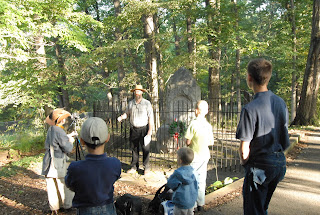Yesterday was the first day of touring. We started by going to Harper's Ferry. Harper's Ferry was where John Brown did they raid which was used to galvanize the North to start the Civil War. Back then, Harper's Ferry was an armory, which was recommended by George Washington in 1792.
John Brown's plan was that with his 21 men, he would surprise the guards, capture the guns, and he thought that during the night 200 slaves would join him from the surrounding plantations. There were 100,000 weapons stored there, so he planned to go to the mountains and defend them from the army, and when he had enough slaves he would march through the South freeing the slaves. This did not work, for a few different reasons. One was that he did not think about transportation for the weapons. Another was that the force of 21 men he attacked with was the largest he had commanded in his life. He could not have commanded 100,000 slaves. Another was that he could not teach 100,000 slaves to load guns who had never used one before. Another was food for his army. Another large one was that the reason he thought the slaves would join him was from reading books like
Uncle Tom's Cabin. Most of the slaves would probably have sided with their master's, not John Brown.
But, he did not make it that far. He and his men were staying in a farmhouse in Maryland which was close to Harper's Ferry. On October 16, 1859, he attacked Harper's Ferry. He crossed the railroad bridge, and captured the guards for the armory stationed at the bridge. Of his 21 men, 16 were whites, and 5 were blacks. He decided to station himself in the engine house, which was used to house the fire engines, and also as a guard house. It was pretty small:

He sent out his men to get hostages, which he thought would be useful. He got about 60 hostages. He had his men spread out through the armory buildings. Then at 2:00 in the morning, the train came through. He decided to stop it so the news would not get through, and also to get more hostages. In the shooting, the first victim of the attack was killed, Hayward Shepherd, the baggage master of the train, who was a free black man. So in the raid to free all of the blacks, the first man killed was one who was already free.
But a doctor got away and called out the militia from the surrounding towns. As said before, John Brown's men were spread out pretty thinly. When the militia came, they gathered in two buildings, which were cut off from each other. In the engine house, John Brown only had 4 men with him. The other building, they soon evacuated, and a few swam across the river, and got away. The militiamen did not attack John Brown's fort, which is what the engine house is called now.
The next day 88 marines came under the command of Robert E. Lee, with J.E.B Stuart as his aide. The militiamen had gotten drunk during the night at the tavern, so Lee commanded it shut down. He asked them if they wanted to attack first, but they said no. So Stuart went up under a flag of truce to ask for the surrender. They refused, as was expected, so Stuart stepped back and waved his hat. This was the signal, so the marines charged. They had brought sledges, but the door had been barricaded, and John Brown had tied ropes, so that if they hit the door, it would just bounce back. So they got a ladder, and using it as a battering ram, they made a hole that was big enough for one man to get through. The first man through was an officer, and he went at John Brown. He tried to cut off his head, but missed and cut his cheek. Then he tried to stab him, but the sword was only a dress sword, and it bent. They ended up capturing them with only one killed and one wounded. All of them were sentenced to be hung, and John Brown was kept in the jail for a month before he was killed. In this time, the Northern press made him a hero, when really he was probably insane.
Next we went to the Jackson Headquarters in Winchester. They had a lot of artifacts from Stonewall Jackson's life, such as his prayer book and field glasses. Then we went to
Kernstown, which was the only tactical defeat in Jackson's Valley Campaign of 1862 but it was strategic victory, since the goal of the campaign was to prevent Banks from reinforcing McClellan. He was misinformed by his
calvary, and thought that he outnumbered the Unions, when really he was outnumbered by them. His men fought bravely, but they were finally driven back by the superior numbers. This was all that we did today.







































